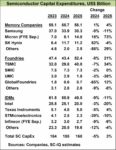– Trump gives CHIPS Act & AI oversight to DOGE/Musk-“Tech Support”
– CHIPS Act to switch from incentive based to tariff/punitive based
– Musk to be responsible for US AI policy & security- Will rule ChatGPT
– Talks underway to relocate Taiwan fabs & staff to avoid China threat
Donald Trump gives CHIPS Act & AI problem to his “tech support” guru, Musk
It was announced by the White House late Monday that the Trump administration is moving responsibility for the much maligned and disliked CHIPS Act out from under the Commerce Department to be under DOGE’s responsibility.
As part of the reorganization, all computer and AI security and policy, most of which was under NIST, which is also part of the Department of Commerce, will also move to be under the control of DOGE.
This will give Musk effective control of Robert Altman and ChatGPT and all things AI which he has long sought by various means including purchase and lawsuits.
It seems that this is a huge reward by Trump for Musk’s support and loyalty to Trump as well Musk being the point man for cutting government spending.
Trump said ” I can think of nobody, in the world, better suited than Elon to take on these highly complex problems with computer chips and artificial intelligence” , he went on to say ” Elon will turn the money losing, stupid CHIPS Act into a tariff driven, money making, American job making thing of beauty”, he further said ” Nobody knows more about artificial intelligence than Elon and his Tesler cars with computer “brains” that can drive themselves”
In discussing the transfer of CHIPS Act & AI to DOGE from the Department of Commerce, White House press secretary Leavitt pointed to Musk’s very strong technology background versus Commerce Department head Lutnick’s primarily financial acumen.
A potential solution to the Taiwan issue as well?
In prior discussions, Musk had commented that the primary reason for China wanting to regain Taiwan was for China to get the critically important semiconductor manufacturing located there. It has been reported by several sources that Musk is putting together a potential plan to move most of the critical, advanced, semiconductor manufacturing out of Taiwan thereby reducing China’s desire to retake the island.
The plan would entail moving the most advanced fabs in Taiwan first, followed by the less capable fabs later. This would obviously be a huge undertaking but would likely be much less costly than a full scale war over Taiwan between the US and China.
Much of the equipment could be moved into already planned fabs in Arizona & Ohio etc. New fab shells would take one to two years to build to house the moved equipment.
Perhaps the bigger issue is where to house all the Taiwanese engineers and their families that would move along with the equipment & fabs. Estimates are that over 300,000 people would have to eventually emigrate to the US. The administration would likely make room for them by the far larger number of illegal immigrants expected to be deported, much of which is already underway.
Make Greenland Green again!
Trump’s interest in Greenland may have a lot more to it than meets the eye. Greenland is rich in rare earth elements, critical to the electronics industry. Greenland is not really green but rather ice covered with hundreds of miles of glaciers amid cold climates. Greenland has plenty of hydroelectric and water, coincidentally what AI data centers and semiconductor fabs need most. In fact semiconductor fabs and power hungry data centers would be perfect in a place that has excess water, electric and perhaps most importantly low temperatures to cool those power hungry, overheated facilities. The heat from those data centers and fabs would likely melt much of the ice cover in Greenland thereby producing more needed water. In the end , the added heating could help turn Greenland “greener ” from its current arctic facade (so much for global warming concerns). Indeed Greenland might be an alternative place to move some relocated Taiwanese fabs and their engineers, they would just have to acclimate to the colder environment.
TaiwanTechTransfer working group & signal chat
There is a secret Signal chat group that is overseeing the semiconductor technology transfer out of Taiwan and Elon Musk is the moderator of the group. Here is your private secret invite link:
TaiwanTechTransfer Secret Signal Chat
Remember, its top secret, don’t share it with anyone!
Merger of Global Foundries & UMC makes for a GLUM foundry
It has been reported in various news sources that Global Foundries and UMC are discussing a merger with the combined entity to be renamed and trading under the ticker symbol GLUM. The combined market share of 6% each would make for a total of 12% market share thereby surpassing Samsung’s roughly 10% market share in foundry. However both foundries produce primarily middling to trailing edge devices that are under attack from the quickly growing China fab capacity thus the name GLUM is appropriate given the future prospects of the market they serve.
Happy April Fools Day!!!!!!
About Semiconductor Advisors LLC
Semiconductor Advisors is an RIA (a Registered Investment Advisor), specializing in technology companies with particular emphasis on semiconductor and semiconductor equipment companies.
We have been covering the space longer and been involved with more transactions than any other financial professional in the space.
We provide research, consulting and advisory services on strategic and financial matters to both industry participants as well as investors.We offer expert, intelligent, balanced research and advice. Our opinions are very direct and honest and offer an unbiased view as compared to other sources.
About Semiwatch
Semiconductor Advisors provides this subscription based research newsletter, Semiwatch, about the semiconductor and semiconductor equipment industries. We also provide custom research and expert consulting services for both investors and industry participants on a wide range of topics from financial to technology and tactical to strategic projects. Please contact us for these services as well as for a subscription to Semiwatch.
Also Read:
CHIPS Act dies because employees are fired – NIST CHIPS people are probationary
Trump whacking CHIPS Act? When you hold the checkbook, you make up the new rules
AMAT- In line QTR – poor guide as China Chops hit home- China mkt share loss?










